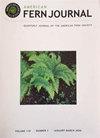哥斯达黎加Talamanca Cordilera多倍体的形态和网状
IF 0.9
4区 生物学
Q4 PLANT SCIENCES
引用次数: 1
摘要
摘要多倍体是植物基因组进化的重要力量,蕨类植物也不例外。Polystichum属的多倍体尤其丰富,估计有44%的属是多倍体。哥斯达黎加和巴拿马的科迪勒拉塔拉曼卡是安第斯和玛雅生物多样性中心之间的一个中路点,这里有三种异源四倍体的Polystichum,其中两种是当地特有的。我们利用来自叶绿体和细胞核的编码和非编码DNA序列来阐明这三个物种的异源多倍体起源。与早期的研究一致,并在此基础上,我们发现证据表明,páramo四倍体最近被命名为Polystichum orbiculatum来自两个不同的安第斯祖先,P. lilianiae来自两个玛雅祖先,P. talamancanum来自一个安第斯祖先和一个玛雅祖先。哥斯达黎加多倍体将安第斯和玛雅地区的遗产纳入其基因组,形成了具有新基因型的新谱系。本文章由计算机程序翻译,如有差异,请以英文原文为准。
Speciation and Reticulation in the Polystichum Allotetraploids of the Costa Rican Cordillera Talamanca
Abstract. Polyploidy is a prominent force in the evolution of plant genomes, and the ferns are no exception. The genus Polystichum is particularly rich in polyploids, with 44% of the genus estimated to be polyploid. A waypoint between the Andean and Mayan centers of diversity, the Cordillera Talamanca of Costa Rica and Panama harbors three allotetraploid species of Polystichum, two of which are endemic. We leverage coding and non-coding DNA sequences from the chloroplast and nucleus to elucidate the allopolyploid origins of the three species. Consistent with, and building upon earlier works, we find evidence that the páramo tetraploid most recently named as Polystichum orbiculatum is derived from two distinct Andean progenitors, P. lilianiae is derived from two Mayan progenitors, and P. talamancanum is derived from one Andean and one Mayan progenitor. The Costa Rican polyploids incorporate the legacy of the Andean and Mayan regions into their genomes, forming new lineages with novel genotypes.
求助全文
通过发布文献求助,成功后即可免费获取论文全文。
去求助
来源期刊

American Fern Journal
生物-植物科学
CiteScore
1.20
自引率
0.00%
发文量
28
审稿时长
6 months
期刊介绍:
The American Fern Journal is a peer-reviewed journal focused on the biology of ferns and lycophytes.
 求助内容:
求助内容: 应助结果提醒方式:
应助结果提醒方式:


